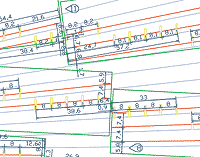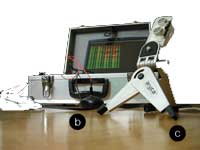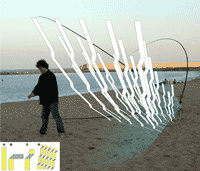Editorial Concepts and factual data
Concepts
Model of work is borrowed from complexity science - systems thinking. Several modules of concepts and constructions are produced, informing each other back and forth, developing as a whole system with no pre-set hierarchy. The conceptual structure develops and changes in relation of the building process. On the threshold of architecture, media design, engineering we try to talk about a new and different relationship between technology and design. The role and effect of technology reveals a more profound relation between design and design tools, and to quote Vilem Flusser here: we try to "turn the automatic apparatus against automation".
Malleable Space
One specific aspect in our work is that many interaction designers or researchers develop a very interesting interaction model, than apply it on a very generic form (screen, interface, furniture), not to take attention away from the interaction. We have a strong interest in developing new structures that carry digital information as low as in materiality or structural qualities.
In our interactive spaces, we are interested in sensing human traces on two levels (eyes of information without mouse or keyboard); through wearable electronic devices and their electronic traces, and through body movement and presence
To find new qualities we rely on experiments and testing on a 1 to 1 scale, rather than using the traditional methods for representation. Even if building installations has physical limits in scale, the hybrid experience becomes real.
The physical structure has mathematical and computational inner logic, it becomes generated and processed form. It has to function as physical structure as well as a projected structure.
The projection becomes volumetric, the physical structure is dissolved in the flux of interactive media, and media become actual and spatial. The interaction we create is symbolic, not really trying to function or process information, but to transform the physical entity in a non physical way .

Low Tech
Example: In the first two versions we used our own non-efficient technology, the Morse-mouse. Due to our limitations in programming and hardware skills, we use Flash as a projection engine, and to interface this program to sensors, we use a computer mouse, and a small device that is clicking Morse code messages on the Mouse button, where flash is listening to those. A human protocol on a human interface.
Low tech and DIY technologies as a strategy can allow architectural scale visions, at least for a transitory state ( http://www.aether.hu/outsidein.htm ) It started out as a necessity and became a choice for our technologies. Trough constant re-appropriation of existing technologies we create new interfaces that hold connotations towards their original use, so stay familiar, but misplaced in a new context. In the near future we hope to test some larger scale experiment with using such mass produced technology and change it for architectural purposes.

Factual data
Induction House V1
Structure dimensions: 100 by 100 by 60 cm
Structure materials: Steel and textiles
Structure resolution: 20 stripes
Structure algorithm: a sliced flat plane unfolded, creating a 100% projectable continuous surface
Projected Media: 6 artificial agents
Sensors: electromagnetic field sensor (sensing mobile phone usage) and a set of light sensors (sensing shadows of hands)
Interaction: mobile phone calls change electronic weather - projected color temperature
visitors placing their hands into the structure attract artificial agents
Exhibited: 2003 October, Kunsthalle Budapest, "in-between", group exhibition on contemporary Hungarian architecture

Induction House V2 (distributed projection structure)
Structure dimensions: 600 by 300 by 170 cm
Structure materials: Steel and textiles
Structure resolution: 300 physical pixels
Structure algorithm: a matrix of pixels moved along the projectors light, creating a a 100% projectable volumetric structure
Projected Media: 3D flows
Sensors: ultrasonic sensors measuring visitors presence and distance
Interaction: spatial flows changed by approaching visitors
Exhibited: 2004 April, Kiasma, Helsinki, Pixelache audiovisual architecture festival

Induction House V3
Structure dimensions: ~ 800 by 400 by 200 cm
Structure materials: Carbon fiber, Steel, Plastic
Structure resolution: ~400 physical pixel-folds
Projected Media: 3D flows
Sensors: spatial computer vision
Interaction: spatial flows changed by approaching visitors, swirling as clouds or mist
Exhibited(upcoming): 2004 August 13-23, Galleri U, International Symposium in Electronic Arts, Helsinki and 2003 September 9-November 9 Venice Biennale of Architecture, Hungarian Pavilion
